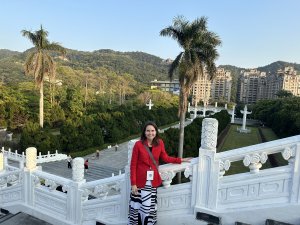
The tram that took me uphill was very interesting and environmentally friendly. It used no gas or any other external energy: it used physics that worked a pulley system that had two cars. As one car goes down the hill, its gravitational acceleration pulls the other one uphill. It was a very quiet tram ride except for the soft but clear words of welcome transmitted through the speaker. As the car ascended, LA became smaller and smaller.
When the tram reached the top, I got off on one side, and passengers who were going downhill got on from the other side. It was a very efficient and non-crowded way of arranging the visitors. I felt like I was beginning to feel the effective management and friendly atmosphere of the Getty. What greeted guests after the tram ride was a very large and strange modern art sculpture. It looked like half a wind sail made from strips of metal; it did not look like any object that I had ever seen in real life.
As I pondered over what that thing was exactly, I followed the crowd up a flight of stone stairs to the entrance of the museum. The entrance had a very unique modern style, and there were visitor-friendly resources. Admission was free, and there were free brochures of museum layout, maps of exhibitions and galleries, free audio tours, and free live tours. I took one map, which had many language choices, and I also checked out a pair of headphones so that I could listen to the audio tour in the galleries. There were many different galleries and various exhibitions; I was interested in the 19th century artworks, so I decided to first visit the gallery that had Impressionist artwork.
I left where the reception building was and went into the courtyard, which was surrounded by the exhibition halls. The courtyard had trees, squares of grassland, tables and chairs, and one fountain that was unfortunately dry due to the observance of water saving initiatives in LA. Also, to the side of one exhibition hall, there was grassy land and a beautiful garden downhill.
I walked towards the building where the Impressionist exhibition was located. I later found out that most pieces in the exhibition were part of the private collection of the previous owner and was later turned into a foundation for promoting arts that allowed public viewing of all these wonderful pieces. I pushed past the glass door and went into see the Impressionist artworks. The format of the exhibition truly surprised me. Usually in a museum, there are many security guards and glass panes that protect the art, or many red lines that hinder visitors from approaching too close. Yet, at the Getty, it was not done. At the Getty, the exhibition rooms reminded me of living rooms. There were sofas and comfortable chairs for visitors to relax in a comfortable position. There were no metal bars or red lines that blocked visitors from looking closely at the artwork. However, there were still several security guards, and whenever the visitors pressed too close, they would intervene, quietly reminding them to view the works at an appropriate distance.
I was fortunate enough to see the works of Degas, Van Gogh, and Gauguin. After I enjoyed the works of the Impressionists, I went into the rooms for 17th and 18th century artwork, which were also very beautiful and wonderful. Also, I was happy to get a chance to see some Cubist works, which were more Modernist types. I even found out that the previous owner collected sketches of the artworks. Looking at the sketches allowed me to glimpse and probe into the painting and art-making process that I was not familiar with before.
The museum had these free and friendly exhibition layouts; thus, I had a very enjoyable afternoon as I sat on the sofas listening to the introductions and looking at the various pieces. I then walked outside to catch a breath of fresh air. I found myself strolling towards the garden. It did not have clear pathways, but instead had winding and twisted walkways. As I walked along this pathway, it took me to places in the garden where I did not think to look. When I got to the middle of the garden, I saw a pond with decorative bushes planted right from the earthy floor of the pond and grew out of the water. Upon closer inspection, I discovered it was a maze. I spent quite a long time enjoying the creative horticulture and trying to figure out the maze. Next to the garden was a grassy hillside where people could sit and picnic. Many families took children here; this is indeed a child-friendly museum. I also noticed that there were many short term exhibitions of photography and other artwork in the different galleries.
The Getty also boasted several trees that changed colors in the fall season; this is a rare scene in LA, where the flora is usually all green year round. From the museum buildings’ balconies, I looked down and saw the panoramic views of LA city. The rush and traffic jams seemed so far and so distant from the hill.
I also noticed that the floor and tiles of the museum were very unique. There were smaller tiles and larger tiles. I could not figure out what kind of pattern they were making. As I looked around, trying to figure it out, I received an astonishing yet brilliant answer. A person told me to look at the tile size for the smaller and larger tiles and told me to observe where the smaller tile appeared and where the larger tiles appeared. I noticed that the smaller tiles were mostly near the doors and entrances to the tram and that the courtyard had larger tiles. It turns out that the designs were very deliberate and that they used the design to indicate where the crowds would be. Smaller tiles indicate a crowded feeling and to remind visitors that this was a place where more people would be walking around. The larger tiles were in places that were more empty and spacious. This was a brilliant design. There were no signs explaining it either. They used art and sizes and shapes to indicate meaning and communicate with visitors. This design indeed did manifest the spirit of this museum: a visitor-friendly, non-intrusive, and non-totalitarian art space where people could relax and truly equally enjoy art.
As I took the tram downhill and ended this journey, I realized that this was indeed a museum that shared art and was based on artistic ideals of not only aesthetics but equality. This was not a museum of expensive, show-off artwork that was guarded jealously by guards and staff. It was a museum that truly appreciated the communicative effectiveness of the art and thus allowed the public to access all the artwork.





